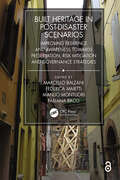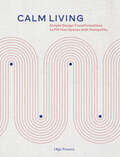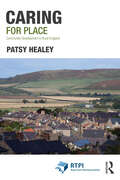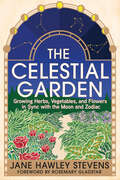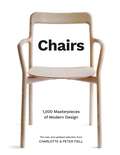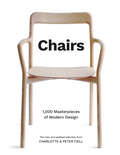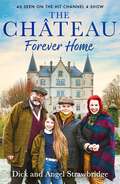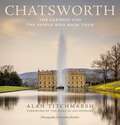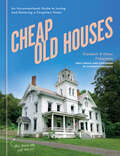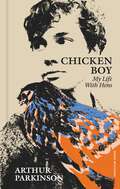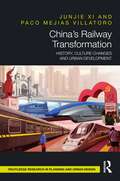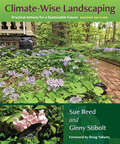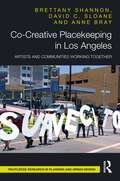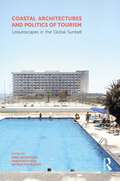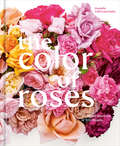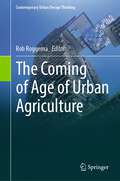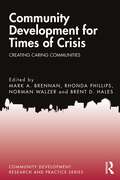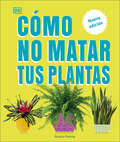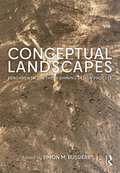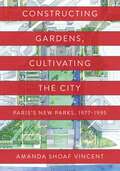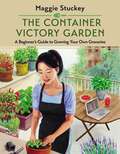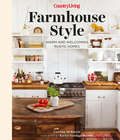- Table View
- List View
Built Heritage in post-Disaster Scenarios: Improving Resilience and Awareness Towards Preservation, Risk Mitigation and Governance Strategies
by Marcello BalzaniIt is assumed that the impact of natural and man-made hazards on society in terms of damage cannot be avoided. To reduce potential disaster levels and to assess which policies have had a positive outcome, a careful comparison should take place on the procedures implemented in the management of crises.The experiences with the earthquakes in the Pianura Padana area and central regions of Italy in the last ten years have been incorporated in the 'After the Damages' advanced training project. This project aims to showcase recent innovations and advancements in post-disaster management, so as to take a more proactive role in post-disaster management, and to respond more effectively when disasters occur.This volume provides insights into the dynamics and negative effects of natural and man-made hazards (i.e., earthquakes, fires, floods, droughts, volcanic eruptions, etc.), including more updated approaches to deal with post-disaster phases. The book also offers tools to deal with possible international crisis scenarios and mitigate the social impact of vulnerabilities through risk reduction.Built Heritage in post-Disaster Scenarios aims at public administration managers, government agency representatives, international organizations, researchers, and professionals in architecture, engineering, and earth science.Marcello Balzani, Architect, PhD in "Representation and Survey", Full Professor of Representation at the Department of Architecture, University of Ferrara. President of Clust-ER Building and Construction. He is author of more than 200 publications on the themes of Drawing and Architectural and Urban Surveying, Project Representation, Management and Visualisation.Federica Maietti, Architect, PhD, Associate Professor in the Scientific Sector ICAR/17 at the Department of Architecture, University of Ferrara. Member of the DIAPReM Centre, since 2005 she carries out research activities in the fields of heritage documentation, survey and diagnostic investigations, in different national and international contexts, including Pompeii, Malta, Brazil, India, and Mexico. Scientific Manager of the International Academy "After the Damages", she is involved in several research activities and she is the author of more than two hundred publications in the field of Heritage Documentation, Survey and Representation.Manlio Montuori, Architect, PhD, former assistant professor non-tenured at the University of Ferrara, Department of Architecture, where he is a member of the Labo.R.A. The main field of his research is the conservation of architectural heritage and landscape, with special emphasis on preservation procedures for traditional and industrial built heritage. His research interests also address assessment and management in the context of damage and disaster risk reduction. Scientific Manager of the International Academy "After the Damages", he is involved in several research projects implementing ICT technologies in the conservation and structural health assessment of built and cultural heritage.Fabiana Raco, Architect, PhD RTDa Researcher of Drawing at the Department of Architecture, University of Ferrara. Technical coordinator of TekneHub Laboratory. Author of more than 50 publications on the topics of Drawing, Architectural and Urban Surveying, Representation, Diagnostics, Visualization and Project Management of interventions on built heritage.
Call It Home: The Details That Matter
by Amber LewisThrough gorgeous photography and heartfelt essays, the interior designer and author of Made for Living reveals her detail-oriented approach to renovating, decorating, and building a beautiful home.The details can make a room. The bullnose edge of a marble countertop. The wood grain and color of the flooring. The particular pleat of the drape. Amber Lewis, the esteemed designer known for her signature California-inspired style, obsesses over the tiniest of features to create her eclectic, laid-back look. In Call It Home, she shares her secrets to choosing and applying fabric, paint, finishes, tile, flooring, and more for a beautifully designed home, shortcutting the often-overwhelming decision-making process. Amber walks you through eight new homes she designed—including her own—and the thought processes behind every major choice. Whether you're decorating one room, renovating your entire house, or planning new construction, she shares how to approach a project from start to finish, guiding you on how to find the right team so you can get the perfect results. Then she takes you through mountain retreats and surfside homes, dreamy escapes she&’s created by pulling inspiration from the surrounding property for a look that&’s unique to each home. Through personal essays, you&’ll learn how she set about the project, what challenges her team faced, and the materials she used to achieve the finished result.With more than 200 gorgeous images of livings rooms, kitchens, dining rooms, entryways, bedrooms, and baths, you'll have photographs of Amber's details on hand when you're ready to create your own collection of stunning spaces—and call it home.
Calm Living: Simple Design Transformations to Fill Your Spaces with Tranquility
by Olga TrusovaDiscover how simple changes can make any room—and its inhabitants—feel more inspired, clear, and energetic. Designer and Stanford instructor Olga Trusova's practical and inspiring guide offers easy-to-follow tips for cultivating a calming environment at home or at work.Using the principles of design thinking, Trusova distills essential design wisdom, revealing how to use light, color, sound, furniture, and more to make simple, intentional changes for a profound impact on your mind, body, and spirit. Illuminating examples, accessible tips, and short exercises reveal how easy it is to transform a space, whether you're targeting a small corner or multiple rooms. Brimming with smart, digestible design tips and life-changing techniques, this stylish handbook makes a lovely self-purchase or gift for creatives, design enthusiasts, at-home workers, and anyone looking for simple, proven ways to design a soothing space.
Caring for Place: Community Development in Rural England (ISSN)
by Patsy HealeyThis book draws on preeminent planning theorist Patsy Healey’s personal experiences as a resident of a small rural town in England, to explore what place and community mean in a particular context, and how different initiatives struggle to get a stake in the wider governance relations while maintaining their own focus and ways of working. Throughout the book, Healey assesses the public value generated by community initiatives and the impact of such activity on wider governance dynamics.Healey explores the power which small communities are able to mobilise through self-organisation and grassroots activism. Through the lens of Wooler and Glendale as a micro-society, the book centres on a community experiencing an economic and demographic transition. It focuses on three initiatives developed and led by local people – a small community development trust, an informal attentionmobilising network, and a Neighbourhood Plan project which uses an opportunity provided within the formal planning system. It examines how, in such civil society activism, people came together to promote local development in a place and community neglected by the dominant political economy.The book details the power and force of community initiative and its potential for transforming both the future possibilities for the place and community itself, as well as wider governance relations. Overall, it seeks to enrich academic and policy discussion about how the relations between formal government and civil society energy could evolve in more productive and progressive directions.
The Celestial Garden: Growing Herbs, Vegetables, and Flowers in Sync with the Moon and Zodiac
by Jane Hawley Stevens“So much thoughtful insight and practical advice is contained in these pages . . . Jane uses nature as a guide to living life in harmony rather than discord.”—Rosemary Gladstar, author of Rosemary Gladstar’s Medicinal Herbs Insight, ideas, and inspiration abound in this highly practical guide to growing successfully in harmony with the moon, the Earth, and other planetary influences. Planting by the moon is an age-old gardening tradition, but did you know that the cycles of the moon and the zodiac can be a powerful tool to improve your success with all kinds of gardening tasks? In The Celestial Garden, longtime gardener and herbalist Jane Hawley Stevens explains how the movement of the moon through the constellations of the zodiac provides a detailed calendar of optimal times for planting seeds, roots, and transplants, as well as for pruning, weeding, propagation, harvesting, and even starting new garden projects or throwing garden parties. While herbs are Stevens’s specialty, she loves growing all kinds of plants, and The Celestial Garden provides excellent gardening tips for every gardener, whether their passion is for vegetables, fruits, herbs, or flowers. At a deeper level, Stevens believes that gardening by the moon and learning about astrological cycles can help restore our elemental interconnection with Nature and the Earth. The Celestial Garden introduces and explains all aspects of astrological gardening: What moon signs are, and why and how the phase of the moon affects plant growth and development How to align the moon’s passage through the constellations of the zodiac with your choice of daily garden tasks and projects Specific tips and advice for the best activities to undertake during each of the moon’s phases How to incorporate simple, creative seasonal rituals into your astrological gardening practice How to design a unique chakra garden How to apply what you learn about astrological influences beyond the garden to experience a greater sense of flow and satisfaction in all aspects of your daily life Photos of the author’s garden throughout the book provide visual evidence of the positive results that come from gardening in harmony with the moon and planetary influences. Illustrations and charts help readers understand the lunar cycle and its influence on plants, the astrological rulers of the body, and the relationship between the signs of the zodiac and the four elements (earth, air, water, fire). Gardeners of every level of experience will find new insights, ideas, and inspiration in this unusual, beautiful, and highly practical guide to the simple yet expansive art of consulting with the cosmos to inform our garden tasks on any given day, week, or month and enjoy greater gardening satisfaction and success. "[Stevens'] advice is plentiful . . [and her] horticultural degree underscore the science of her work."—Booklist “A unique and wonderful book, brimming with the knowledge and skills that arise from a lifetime in herbalism. . . This book is a major contribution to herbalism’s role not only in the alleviation of suffering, but the transformation of human consciousness. Thank you, Jane!”—David Hoffmann, RH (AHG), fellow, National Institute of Medical Herbalists; principal scientist, Traditional Medicinals "In this easy-to-understand guidebook, Jane Hawley Stevens demystifies the moon and stars in relationship with nature and explains how you can use their powerful cycles to make your garden the most beautiful, bountiful, and happiest it can be."—Maria Rodale, author of Love, Nature, Magic
Chairs: 1,000 Masterpieces of Modern Design, 1800 to the Present Day
by Charlotte Fiell Peter FiellFrom Alvar Aalto to Marco Zanuso, Chairs introduces over 1,000 groundbreaking innovations by the world's greatest designers. Tracing the history of the modern chair from 1800 to the present day, revered experts Charlotte and Peter Fiell comprehensively guide you through the fascinating world of seating design – from the functional office chair to the limited edition art piece.With more than 1,000 exquisite images alongside fascinating insights into the conception, design and production of these masterpieces, this definitive collection includes design classics such as Josef Hoffmann's Sitzmaschine, Robin Day's Polyprop and computer-generated masterworks by Zhang Zhoujie, amongst many more.
Chairs: 1,000 Masterpieces of Modern Design, 1800 to the Present Day
by Charlotte Fiell Peter FiellThis updated edition features designs from 1800 up to present day, and features the biggest names in furniture design, art, architecture and craft.
Chairs: 1,000 Masterpieces of Modern Design, 1800 to the Present Day
by Charlotte Fiell Peter FiellThis updated edition features designs from 1800 up to present day, and features the biggest names in furniture design, art, architecture and craft.
The Chateau - Forever Home: The final chapter of our greatest adventure
by Dick Strawbridge Angel StrawbridgeReturn to life at Château-de-la-Motte Husson in the concluding memoir from Sunday Times bestselling authors, Dick and Angel Strawbridge.Picking up from where Living the Château Dream ended, Dick and Angel recount the newest and biggest challenges they faced on the journey to transforming their once derelict and abandoned château in France's Pays de la Loire into a thriving family home and sustainable business.When the Covid-19 pandemic engulfs the world, the château faces a new challenge and the Strawbridges must find ways to adapt in order to keep their dream life in France alive. From the cancellation of the wedding season to finding new ways to complete renovations, living in an isolated bubble whilst continuing to film their TV series through to life after the pandemic, this is Dick and Angel at their most honest and heartfelt, revealing many details never seen on TV.As entertaining, warm and irresistible as ever, this is the final chapter in Dick and Angel's remarkable journey to find their family's forever home.
Chatsworth: The gardens and the people who made them
by Alan TitchmarshDiscover Jane Austen's real-life inspiration for Darcy's Pemberley.Follow Alan into Chatsworth's irresistible world of visionaries, pioneers, heroes, villains and English eccentrics, and celebrate the men and women who have shaped the history of the estate over five centuries. With his passionate knowledge of both the house and gardens, as well as his long-established relationship with the Cavendish family, Alan is the perfect guide with whom to explore the Palace of the Peaks.Featuring stunning, specially commissioned photography of the gardens and parkland, alongside long-forgotten images and memorabilia newly unearthed in the estate archives, this vivid companion, crowded with character and colour, is a book to treasure and revisit over and over again.
Cheap Old Houses: An Unconventional Guide to Loving and Restoring a Forgotten Home
by Elizabeth Finkelstein Ethan FinkelsteinFrom the founders of the HGTV show and Instagram Cheap Old Houses comes a stunning collection of beautiful, affordable homes and inspiration for buying and restoring an historic house.Welcome to the magical world of Cheap Old Houses, where the new American dream comes with zero mortgage and an affordable lifestyle fit for a storybook. Ethan and Elizabeth Finkelstein have scoured the country to find homes in desperate need of saving—including a $45,000 Victorian in Mississippi, a $25,000 mansion in Indiana, an $82,000 recreational camp in Maine, and more. Cheap Old Houses features the stories of how these homes were acquired and lovingly restored.Within these pages, you&’ll discover sprawling Victorian mansions, Italianate-style farmhouses, off-the-beaten-path cabins, and even old churches turned into residences. You&’ll meet a couple who camped out on their back porch while they made their 6,000-square foot manor livable, and homeowners who found a free bungalow and moved it seventy miles to their property. Additionally, Elizabeth, a historical preservationist, gives information on the details to preserve in historic houses, from pocket doors that might be hiding in the walls to badly cracked plaster walls that are worth repairing and butler&’s pantries that are once again more desirable for storing dishes and small appliances.With hundreds of beautiful photographs capturing these homes in all their glory, you&’ll be inspired to find &“the one&”—a fixer upper to rescue that will rescue you right back.
Chicken Boy: My Life With Hens
by Arthur ParkinsonA captivating, beautifully illustrated memoir of a life in nature, and a testament to the mutual rewards and delights of keeping chickens, by the Sunday Times bestselling author of The Flower Yard'I am a toddler the first time I meet a chicken, and we are equal in size and height. The hen has tiny eyelashes, a strawberry-jam face and a voice of purring clucks. I sense a happy spirit of inquisitiveness and smile in fascination. From that moment on, I will always love the company of chickens. I have found my tribe'Most of us want a dog, or a cat, or a pony when we are young - for Arthur Parkinson, it was always hens. Growing up in an ex-mining town in Nottinghamshire, the other kids in the playground called him 'Chicken Boy'. But the quiet fulfilment of keeping hens became his sanctuary, a tonic for mental and physical health, a connection with his family and the natural world. From the local allotments and his nan's back garden, to Chatsworth and an unlikely friendship with the late Duchess of Devonshire, a famous hen-keeper, Chicken Boy tells the story of the love and satisfaction to be found in caring for living things.Illustrated with Arthur's own characterful watercolours and photographs of his 'girls', and laden with practical hen-keeping tips, gardening advice and introductions to common, rare and pure breeds, Chicken Boy is a one-of-a-kind memoir of a life in nature.
China’s Railway Transformation: History, Culture Changes and Urban Development
by Junjie Xi Paco Mejias VillatoroThis book investigates China’s railway transformation through history, along with culture changes and urban development. The book begins by looking at the background of China and the history and growth of railway development in China through five key phases, followed by assessing the cultural changes in the railway carriage and exploring how these are linked to social equality and national provisions. The core of this book aims to analyse the Chinese urban transformation through the development of the high-speed rail (HSR) infrastructure in China. Eleven important new HSR stations in mainland China, plus the new Hong Kong West Kowloon Station, have been selected to contextually explore how HSR infrastructures have affected the development of the Chinese urban context. The selected case studies are the stations of Beijing South, Wuhan, Shanghai Hongqiao, Guangzhou South, Xi’an North, Nanjing South, Chengdu East, Tianjin West, Zhengzhou East, Hangzhou East and Hong Kong West Kowloon. All of these were built between 2008 and 2018. In these case studies, the location and the intentions and success of promoting urban development are analysed and assessed. Following this, the book further investigates the peculiarities of the new HSR stations in China in comparison with stations in Europe. An assessment framework is established to evaluate the Chinese case studies comparatively with significant cases in Europe, attending to the urban structure of the area, the architectural quality, the functional diversity and the quality of the public space generated in the surrounding area.
Climate-Wise Landscaping: Practical Actions for a Sustainable Future, Second Edition
by Sue Reed Ginny StiboltWhat can we do, right now, in our own landscapes, to help solve climate change? Gold Winner, Foreword INDIES Book Awards: Ecology & Environment “Read this book carefully. Everything you need to know to help heal our relationship with planet Earth and empower you to make a much-needed difference is within these pages.”—From the foreword by Doug Tallamy Praise for the first edition: “The volume of information here is impressive, and each action is accompanied by an explanation of why it’s important. . . . Useful whether read cover-to-cover or dipped into for specific topics.”—Booklist“Beautifully designed, the book is user-friendly and attractive. The information is current and science-based, with end-notes that give readers access to further research.”—Virginia Native Plant Society “This fantastic resource is filled with climate-wise solutions for anyone who owns or manages a piece of ground—even if it’s just a few containers on a tiny rooftop garden.”—Claudia West, ASLA, Principal, Phyto Studio LLC “[Reed and Stibolt] articulate a new gardening aesthetic. . . . The result is a positive and hopeful story of how people can use their imagination and ingenuity to help craft more resilient landscapes.”—Dr. Peter Robinson, former CEO, David Suzuki Foundation “Beautiful photos and pleasing graphics illustrate key ideas and actions while informative sidebars and inspiring quotes from climate and landscape experts provide clarity of complex systems and motivation to adapt to a changing future.”—Julie Richburg, Ph.D., ecologist “A book on climate-wise landscaping could not be more timely or more necessary. We are moving into a new and critical era, and this book takes landscape professionals and home gardeners where they need to go.”—Owen Dell, RLA, ASLA, landscape architect, educator, author, Owen Dell & Associates “A very useful guide to designing landscapes for the twenty-first century which clearly respond to our changing climate.”—Darrel Morrison, honorary associate faculty member in landscape architecture, University of Wisconsin-Madison Predictions about future effects of climate change range from mild to dire—but we’re already seeing warmer winters, hotter summers, and more extreme storms. Proposed solutions often seem expensive and complex and can leave us as individuals at a loss, wondering what, if anything, can be done.Sue Reed and Ginny Stibolt offer a rallying cry in response—instead of wringing our hands, let's roll up our sleeves. Based on decades of the authors' experience, this book is packed with simple, practical steps anyone can take to beautify any landscape or garden, while helping protect the planet and the species that call it home. Topics include: Working actively to shrink our carbon footprint through mindful landscaping and gardeningCreating cleaner air and waterMaximizing resource efficiencySupporting birds, butterflies, pollinators, and other wildlife. As climate change continues to intensify around the globe, the information in this second edition of Climate-Wise Landscaping is needed now more than ever. This book is the ideal tool for homeowners, gardeners, and landscape professionals who want to be part of the solution to climate change.
Co-Creative Placekeeping in Los Angeles: Artists and Communities Working Together (Routledge Research In Planning And Urban Design Ser.)
by Brettany Shannon David C. Sloane Anne BrayCo-Creative Placekeeping in Los Angeles is a novel examination of Los Angeles-based socially engaged art (SEA) practitioners’ equitable placekeeping efforts. A new concept, equitable placekeeping describes the inclination of historically marginalized community members to steward their neighborhood’s development, improve local amenities, engage in social and cultural production, and assert a mutual sense of self-definition—and the efforts of SEA artists to aid them. Emerging from in-depth interviews with eight Southern California artists and teams, Co-Creative reveals how artists engage community members, sustain relationships, and defy the presumption that residents cannot speak for themselves. Drawing on these artists and theoretical analysis of their praxes, the book explicates equitable community engagement by exploring not just the creative projects but also the underlying phenomena that inspire and sustain them: community, engagement, relationships, and defiance. What further sets this book apart is how it deviates from the conventional who and what of SEA projects to foreground the how and the why that inspire and necessitate collectively creative action. Co-Creative is for anyone studying arts-based community development and gentrification, given it complicates and enriches the current conversation about art’s undeniable and increasingly controversial role in neighborhood change. It will also be of interest to researchers and students of urban studies.
Coastal Architectures and Politics of Tourism: Leisurescapes in the Global Sunbelt
by Sibel BozdoǧanThis volume offers a critical and complicated picture of how leisure tourism connected the world after the World War II, transforming coastal lands, traditional societies, and national economies in new ways. The 21 chapters in this book analyze selected case studies of architectures and landscapes around the world, contextualizing them within economic geographies of national development, the geopolitics of the Cold War, the legacies of colonialism, and the international dynamics of decolonization. Postwar leisure tourism evokes a rich array of architectural spaces and altered coastal landscapes, which is explored in this collection through discussions of tourism developments in the Mediterranean littoral, such as Greece, Turkey, and southern France, as well as compelling analyses of Soviet bloc seaside resorts along the Black Sea and Baltic coasts, and in beachscapes and tourism architectures of western and eastern hemispheres, from Southern California to Sri Lanka, South Korea, and Egypt. This collection makes a compelling argument that "leisurescapes," far from being supra-ideological and apolitical spatial expressions of modernization, development, and progress, have often concealed histories of conflict, violence, social inequalities, and environmental degradation. It will be of interest to architectural and urban historians, architects and planners, as well as urban geographers, economic and environmental historians.
Coastal Architectures and Politics of Tourism: Leisurescapes in the Global Sunbelt
by Sibel BozdoǧanThis volume offers a critical and complicated picture of how leisure tourism connected the world after the World War II, transforming coastal lands, traditional societies, and national economies in new ways.The 21 chapters in this book analyze selected case studies of architectures and landscapes around the world, contextualizing them within economic geographies of national development, the geopolitics of the Cold War, the legacies of colonialism, and the international dynamics of decolonization. Postwar leisure tourism evokes a rich array of architectural spaces and altered coastal landscapes, which is explored in this collection through discussions of tourism developments in the Mediterranean littoral, such as Greece, Turkey, and southern France, as well as compelling analyses of Soviet bloc seaside resorts along the Black Sea and Baltic coasts, and in beachscapes and tourism architectures of western and eastern hemispheres, from Southern California to Sri Lanka, South Korea, and Egypt. This collection makes a compelling argument that "leisurescapes," far from being supra-ideological and apolitical spatial expressions of modernization, development, and progress, have often concealed histories of conflict, violence, social inequalities, and environmental degradation. It will be of interest to architectural and urban historians, architects and planners, as well as urban geographers, economic and environmental historians.
The Color of Roses: A Curated Spectrum of 300 Blooms
by Danielle Dall'Armi Hahn&“The roses are glorious! The story of the rose farm, incredible. The photographs by Victoria Pearson, utterly extraordinary.&”—MARTHA STEWARTA unique photographic collection of 300 stunning roses that spans the full spectrum of the flower&’s shades and hues, creating a breathtaking rainbow that will amaze flower lovers of all kinds.Few flowers come in as many colors as the beloved rose. Curated by award-winning rosarian Danielle Dall&’Armi Hahn, who personally owns more than 40,000 roses, the flowers in The Color of Roses were selected not only for their glorious and subtle color combinations but also for optimal availability, repeat blooming, disease resistance, improved vase life, and fragrance.Organized by color, these 300 full-page photos take you on a journey through all the marvelous shades of white, yellow, pink, peach, purple, orange, red, caramel, and even green blossoms—not to mention striped and bicolor. This modern compilation of the world&’s 300 most beautiful roses includes the essential statistics for each one, including name, plant type and size, breeder, and more to help gardeners, rose lovers, and floral designers discover their new favorite.Roses have been treasured for centuries. They bloom from spring until frost, in virtually all but the most frigid zones and in a great range of varieties to suit every taste. The Color of Roses is the ultimate guide for selecting the perfect color rose for your garden, special event, or floral arrangement.
The Coming of Age of Urban Agriculture (Contemporary Urban Design Thinking)
by Rob RoggemaFor a long time, urban agriculture initiatives have been explored and novel policy and planning practices have been investigated. With the global food crisis the role urban agriculture has to play becomes more and more urgent. The potentials are large: it brings social justice, it limits climate change, it provides a healthy urban condition, it stimulates biodiversity and gives disadvantaged people an economic opportunity. After 15 years in the making, the time is ripe to see whether the growing of food has established a prominent position in urban planning and policies, food productivity, safety and security, social well-being, the arts, and human health. In this volume several aspects of growing food in the city are explored. Urban Agriculture plays a significant role in society. Nevertheless, it did not become a mainstream topic in day-to-day practice. This book provides concrete solutions and clues how to give urban food production a crucial role in the future planning of urban environments.
Community Development for Times of Crisis: Creating Caring Communities (Community Development Research and Practice Series)
by Mark A. BrennanThis book explores the intersection of community development and local capacity building as a basis for effective disaster mitigation and the alleviation of suffering in times of crisis. Beginning with the Community Development section, the process, context, and methods for community, engagement, and development can be viewed from different structural and logical approaches. This section explores some of the more relevant historical arguments, as well as more contemporary examinations. The second section looks at Critical Human and Community Considerations and sheds light on some of the key concepts that are often overlooked (poverty, race, inequality, social justice, mental health, social division) when framing community responses to disaster. The third section focuses on Fundamental Elements of Caring Communities. This section explores the importance, practical, and measurable impacts of social support, empathy, inclusion, and conflict resolution in creating effective and caring community responses. Finally, the last section focuses on practice and brings together research and theory into applied programming, examples, and evidence from on-the-ground efforts to establish caring communities that respond to local needs in times of crisis and beyond. By addressing these objectives, this book provides a more complete understanding of the essential role that community can play in disaster mitigation. Doing this will provide a better focus for ongoing research endeavors, and program and policy initiatives at the community level that seek to prepare for, respond to, and recover from natural and other disasters. As a result, this book contributes to wider and more sustainable development of our communities beyond disasters, while furthering dialog among community scholars and practitioners.
Cómo no matar tus plantas (How Not to Kill Your Houseplant): Nueva edición
by Veronica PeerlessPor mucho que riegues tus plantas siguen estando débiles: hojas que se caen, amarillean y tienen manchas. ¿Qué ocurre? Esta guía de plantas de interior te explica de manera fácil los problemas que pueden estar sufriendo.Detecta las señales de peligro, aprende cómo puedes rescatarlas y descubre qué planta se adapta mejor a tus necesidades. Puedes colocarlas en espacios muy diferentes: baños, cuartos fríos, encima del escritorio, en el marco de una ventana, en un rincón sombrío o en un solárium caliente. ¡Crea tu propio oasis dónde tú quieras!Este libro de plantas también incluye: Consejos para comprender qué les gusta y qué no.Indicaciones sobre cuánta luz, agua, calor y humedad necesitan.Explicaciones para principiantes de las diferentes etapas de crecimiento de la planta.¡Pasa las páginas y descubre cómo salvar a tus plantas! Identifica qué hay plantado en tu maceta y asegúrate de que crezca sana y fuerte. El regalo perfecto para todo aquel que busca poner una planta en su vida y para amantes de las plantas con poca experiencia que quieren adquirir nuevos conocimientos. -------------------------------Learn all the tips and tricks you need to become a proud plant parent – of more than 100 different plants.Yellowed leaves, drooping leaves, dried leaves, even though you've watered it: what&’s going on? How Not to Kill Your Houseplant will explain – and fix – your houseplant woes. Learn to spot the danger signs and take the proper action to rescue your sick plant. Discover the perfect plant for your unique space and needs. Bathrooms, cold rooms, at a desk, on a windowsill, in a gloomy corner or hot suntrap: there are plants for every location to create your own indoor oasis.This perfect plant book further features: Quick tips to understand what your plant does and doesn't like: How much light, water, food, heat, and humidity. Every stage of plant parenting for beginners, from identifying exactly what's in the pot, to keeping it in check when it grows too well. Proving the idea self-purchase or gift purchase for complete beginners who have no experience with or knowledge of plants, as well as [people who want to increase the amount of greenery in their life with indoor plants.
Conceptual Landscapes: Fundamentals in the Beginning Design Process
by Simon M. BussiereConceptual Landscapes explores the dilemma faced in the early moments of design thinking through a gradient of work in landscape and environmental design media by both emerging and well-established designers and educators of landscape architecture. It questions where and, more importantly, how the process of design starts. The book deconstructs the steps of conceptualizing design in order to reignite pedagogical discussions about timing and design fundamentals, and to reveal how the spark of an idea happens – from a range of unique perspectives. Through a careful arrangement of visual essays that integrate analog, digital, and mixed-media works and processes, the book highlights differences between diverse techniques and triggers debate between design, representation, technology, and creative culture in the field. Taken together, the book’s visual investigation of the conceptual design process serves as a learning tool for aspiring designers and seasoned professionals alike. By situating student work alongside that of experienced teachers and landscape architects, the book also demystifies outdated notions of individual genius and sheds new light on the nearly universally messy process of discovery, bridged across years and diverse creative vocabularies in the conceptual design process. Lavishly illustrated with over 210 full color images, this book is a must-read for students and instructors in landscape architecture.
Constructing Gardens, Cultivating the City: Paris’s New Parks, 1977-1995 (Penn Studies in Landscape Architecture)
by Amanda Shoaf VincentConstructing Gardens, Cultivating the City is the first cultural history of major new parks developed in Paris in the late twentieth century, as part of the city’s program of adaptive reuse of industrial spaces. Thanks to laws that gave the city more political autonomy, Paris’s local government launched a campaign of park creation in the late 1970s that continued to the turn of the millennium. The parks in this book represent this campaign and illustrate different facets of their cultural and historical context.Archival research, interviews, and analyses of the parks reveal how postmodern debates about urban planning, the historic city, public space, and nature’s presence in an urban setting influenced their designs. In sum, the city adopted the garden as a model for public parks, investing in complex, richly symbolic and representational spaces. These parks were intended to represent contemporary twists on traditional designs and serve local residents as much as they would contribute to Paris’s role as a world city.The parks’ development process often included points of conflict, pointing to differing views on what Parisian space should represent and fundamental contradictions between the characteristics of public space and the garden as it is traditionally defined. These parks demonstrate the ongoing cultivation of the city over time, in which transformed sites not only fulfil new functions but also engage with history and their surroundings to create new meaning. They stand for landscape as a form of signifying cultural production that directly engages with other art forms and ways of knowing. Just as the Luxembourg Gardens, the Tuileries, and the Buttes-Chaumont parks exemplify their eras’ cultural dynamics, such parks as the Jardin Atlantique, Parc André-Citroën, and the Jardin des Halles express contemporary French culture within the archetypal space of their era, the city. Finally, they point the way to current trends in landscape architecture, such as citizen gardening and ecological initiatives.
The Container Victory Garden: A Beginner’s Guide to Growing Your Own Groceries
by Maggie StuckeyEven if all you have is a postage stamp's worth of space on a balcony, patio, or front stoop, The Container Victory Garden equips you to dig into the joys of container gardening, right where you are.Imagine this: In the morning, you pluck a few mint leaves from your backdoor herb garden and add them to your tea. A few hours later, you step out onto your patio and collect a handful of lettuce leaves for your lunch salad. Just before dinner, you harvest a few basil leaves and cherry tomatoes for a delicious caprese pasta.In her trademark warm and informative style, bestselling author and expert gardener Maggie Stuckey shares everything you need to know to succeed with container gardening: planning, gearing up, planting, nurturing, and harvesting.In The Container Victory Garden, you will find:detailed line art drawings that illustrate many gardening techniques and set-upsfirst-person stories of World War II Victory Gardens and their inspiration for today's gardenersbeautiful full-color paintings of diverse people enjoying their container gardensThis is the promise of container gardening: a fresh bounty of vegetables, herbs, and edible flowers you can enjoy in every season.
Country Living Farmhouse Style: Warm and Welcoming Rustic Homes
by Caroline McKenzieAdd rustic country charm and make home your favorite place to be. This collection of classic and modern farmhouses inspire easy and comfortable living. Farmhouse style is about cultivating connection, embracing the simple life, and bringing a kick-up-your-feet, linger-a-little-longer feeling to your home. Step inside 20 beautifully-designed homes and discover how to create the cozy and practical country vibe. An intimate look inside these homes reveals how designers blend elements of old and new and add a touch of distinctive character to every room. You&’ll tour a renovated New York farmhouse that pairs classic architecture with a fresh color palette for a hip yet historic look and discover how designer Lauren Leiss artfully refreshes a Virginia Colonial-style home with reclaimed floors and exposed beams. Plus, peek inside a ranch-style Texas home built from scratch which displays old-time charm inside and out. (Think: tons of textured cozy lived-in rooms featuring aged furniture and collections of time-worn books and oiled paintings.)Whether you are looking to upgrade your kitchen with an apron-front sink, add shiplap to your walls, or introduce flair to your living space with flea market finds, this expansive collection of farmhouses will inspire homeowners who plan to renovate or decorate a new home or make the perfect gift for anyone who dreams of a farmhouse of their own.
